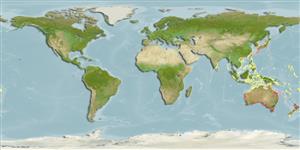>
Gobiiformes (Gobies) >
Gobiidae (Gobies) > Gobiinae
Etymology: Favonigobius: Latin, favonius = gentle, propicious and Latin, favonianus = the west wind; 1656 + Latin, gobius = gudgeon (Ref. 45335).
More on author: Macleay.
Environment: milieu / climate zone / depth range / distribution range
Ecología
marino; salobre demersal. Temperate
Western Pacific: eastern Australia, including Tasmania; also in New Zealand (Ref. 5755).
Tamaño / Peso / Age
Maturity: Lm ? range ? - ? cm
Max length : 9.0 cm TL macho / no sexado; (Ref. 9002)
Facultative air-breathing in the genus (Ref. 126274); Found in shallow sandy estuaries, often in seagrass beds (Ref. 9002).
Life cycle and mating behavior
Madurez | Reproducción | Puesta | Huevos | Fecundidad | Larva
Kuiter, R.H., 1993. Coastal fishes of south-eastern Australia. University of Hawaii Press. Honolulu, Hawaii. 437 p. (Ref. 9002)
IUCN Red List Status (Ref. 130435: Version 2024-2)
Threat to humans
Harmless
Human uses
Herramientas
Special reports
Download XML
Fuentes de Internet
Estimates based on models
Preferred temperature (Ref.
123201): 14.6 - 26.2, mean 18.6 °C (based on 596 cells).
Phylogenetic diversity index (Ref.
82804): PD
50 = 0.5020 [Uniqueness, from 0.5 = low to 2.0 = high].
Bayesian length-weight: a=0.00724 (0.00339 - 0.01546), b=3.10 (2.92 - 3.28), in cm total length, based on LWR estimates for this (Sub)family-body shape (Ref.
93245).
Nivel trófico (Ref.
69278): 3.5 ±0.4 se; based on size and trophs of closest relatives
Resiliencia (Ref.
120179): Alto, población duplicada en un tiempo mínimo inferior a 15 meses (Preliminary K or Fecundity.).
Fishing Vulnerability (Ref.
59153): Low vulnerability (10 of 100).
Nutrients (Ref.
124155): Calcium = 235 [111, 875] mg/100g; Iron = 0.968 [0.393, 2.345] mg/100g; Protein = 17.8 [15.6, 19.8] %; Omega3 = 0.328 [0.094, 1.119] g/100g; Selenium = 12.5 [3.5, 42.3] μg/100g; VitaminA = 6.9 [1.2, 36.4] μg/100g; Zinc = 1.98 [1.07, 3.51] mg/100g (wet weight);
